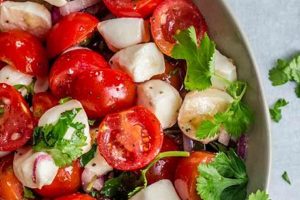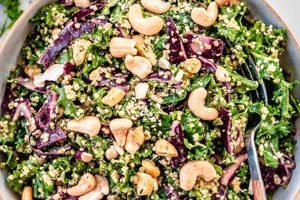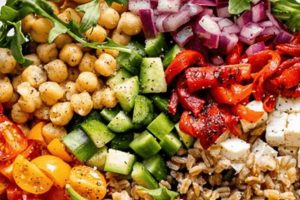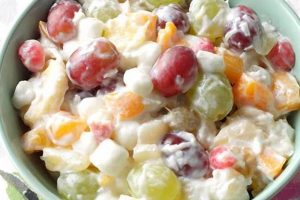Flavorful and nutritious salads centered around spinach offer a versatile culinary canvas. These dishes can range from simple combinations of fresh spinach, vinaigrette, and a few toppings, to more complex creations incorporating roasted vegetables, cheeses, nuts, seeds, fruits, and various proteins. An example might include baby spinach tossed with a warm bacon vinaigrette, crumbled goat cheese, toasted pecans, and sliced strawberries.
Spinach salads contribute significantly to a healthy diet due to spinach’s rich nutrient profile. This leafy green is an excellent source of vitamins A, C, and K, as well as folate, iron, and magnesium. The addition of other ingredients further enhances the nutritional value and creates a balanced meal option. Historically, spinach has been cultivated for centuries, and its use in salads has evolved alongside culinary traditions, reflecting regional preferences and seasonal availability.
This discussion will explore various aspects of preparing exceptional spinach salads, including selecting the freshest ingredients, creating complementary flavor combinations, and mastering techniques for proper washing, storing, and serving.
Tips for Exceptional Spinach Salads
Achieving a truly delicious and satisfying spinach salad involves careful consideration of various factors, from ingredient selection to preparation techniques. The following tips offer guidance for creating outstanding salads.
Tip 1: Prioritize Fresh, High-Quality Spinach: Opt for vibrant, deep green leaves free from wilting or discoloration. Thoroughly wash and dry the spinach before using to remove any grit or debris.
Tip 2: Balance Flavors and Textures: Consider incorporating a variety of ingredients to create a multi-dimensional experience. Combine creamy cheeses with crunchy nuts, sweet fruits with tangy dressings, and savory proteins with earthy vegetables.
Tip 3: Dress Strategically: Add dressing just before serving to prevent the spinach from becoming soggy. Toss gently to ensure even coating.
Tip 4: Explore Different Dressings: Move beyond basic vinaigrettes and experiment with flavorful options like creamy balsamic, honey mustard, or lemon-tahini dressings.
Tip 5: Don’t Overcrowd the Salad: Too many ingredients can overwhelm the delicate flavor of spinach. Focus on a few key components that complement each other well.
Tip 6: Consider Warm Elements: Incorporating roasted vegetables, grilled chicken or fish, or a warm bacon vinaigrette adds depth and complexity to the salad.
Tip 7: Proper Storage is Key: Store unwashed spinach in a sealed container lined with paper towels in the refrigerator’s crisper drawer to maintain freshness.
By following these tips, one can elevate a simple spinach salad into a culinary masterpiece that is both healthy and satisfying. Careful attention to detail ensures a delightful dining experience.
In conclusion, crafting exceptional spinach salads is an achievable goal with a little knowledge and practice. The combination of fresh, high-quality ingredients, balanced flavors, and proper techniques will yield consistently delicious results.
1. Fresh, High-Quality Spinach
The foundation of any exceptional spinach salad lies in the selection of fresh, high-quality spinach. Its inherent flavor and texture significantly influence the final dish, impacting both nutritional value and overall enjoyment. Understanding the characteristics of superior spinach allows for informed choices that elevate the salad from ordinary to extraordinary.
- Visual Cues:
Vibrant, deep green leaves, free from yellowing, browning, or wilting, signify freshness. Leaves should appear crisp and full, not limp or damaged. Uniform size and shape within a given variety also suggest careful handling and storage.
- Texture:
Fresh spinach exhibits a tender yet slightly firm texture. Leaves should be pliable, not brittle or slimy. Avoid spinach with a gritty or sandy feel, which indicates inadequate washing or the presence of residual soil.
- Aroma:
High-quality spinach possesses a clean, slightly earthy aroma. Any off-putting odors, such as mustiness or sourness, indicate spoilage or improper storage. A fresh, mild scent suggests optimal quality.
- Sourcing:
Whenever possible, sourcing spinach from local farmers markets or reputable grocers ensures optimal freshness. Look for spinach that has been minimally processed and stored appropriately. Inquiring about harvest dates can provide further insight into the spinach’s age and expected shelf life.
By prioritizing these indicators of quality, one ensures the spinach salad begins with the best possible ingredients. This attention to detail translates directly to a more flavorful, nutritious, and visually appealing final product, highlighting the crucial role of fresh spinach in achieving culinary excellence.
2. Complementary Flavor Pairings
The success of a spinach salad hinges significantly on the harmonious interplay of flavors. Complementary pairings elevate the dish beyond a simple combination of ingredients, creating a nuanced and satisfying culinary experience. Strategic flavor combinations enhance the inherent qualities of spinach, transforming a basic salad into a memorable dish.
- Sweet and Savory Contrasts:
The slight bitterness of spinach provides an ideal backdrop for both sweet and savory elements. Pairing sweet components like berries, dried fruits, or caramelized onions with savory ingredients such as bacon, crumbled cheese, or roasted nuts creates a balanced and complex flavor profile. For instance, the sweetness of strawberries complements the saltiness of feta cheese, while the earthiness of spinach anchors the combination.
- Acidic Accents:
Acidity brightens the flavor of spinach and cuts through richness. Citrus fruits, like oranges or grapefruit segments, or acidic dressings, such as vinaigrettes with lemon juice or vinegar, provide a refreshing counterpoint to other ingredients. The tartness of a lemon vinaigrette enhances the sweetness of dried cranberries and the nuttiness of pecans, creating a well-rounded flavor experience.
- Textural Variety through Flavor:
Different textures contribute to the overall enjoyment of a salad. Crunchy elements, such as toasted nuts, seeds, or croutons, contrast with the soft spinach leaves, while creamy cheeses or avocados provide a smooth counterpoint. Toasted almonds add a satisfying crunch alongside the creamy texture of goat cheese, further enhancing the salad’s complexity.
- Umami Depth:
Incorporating umami-rich ingredients adds depth and savoriness to spinach salads. Mushrooms, roasted vegetables, or aged cheeses contribute a savory dimension that complements the other flavors. The umami notes of roasted shiitake mushrooms complement the sweetness of dried apricots and the tanginess of a balsamic vinaigrette, creating a sophisticated flavor profile.
By carefully considering the interplay of these flavor components, one can create spinach salads that offer a harmonious balance and a truly satisfying culinary experience. The strategic combination of contrasting and complementary flavors elevates the simple spinach salad to a dish of remarkable complexity and depth.
3. Balanced Textures and Colors
Sensory appeal plays a crucial role in the overall enjoyment of food. In the context of spinach salads, achieving a balance of textures and colors contributes significantly to a positive dining experience. Visual and tactile variety enhances the inherent qualities of the ingredients, elevating the salad from merely nutritious to genuinely delightful. This balance engages multiple senses, creating a more satisfying and memorable meal.
- Textural Contrast:
A combination of textures adds complexity and interest to a spinach salad. The smooth, slightly yielding texture of spinach leaves benefits from the incorporation of contrasting elements. Crunchy components, such as nuts, seeds, croutons, or raw vegetables like carrots or bell peppers, provide a satisfying counterpoint. Creamy ingredients, such as avocado, cheese, or a soft-boiled egg, introduce another layer of textural variation. This interplay prevents monotony and creates a more dynamic eating experience.
- Visual Appeal through Color:
Color variety stimulates appetite and enhances the visual presentation of a spinach salad. The deep green of spinach serves as an excellent backdrop for a range of vibrant colors. Bright red tomatoes, orange carrots, yellow bell peppers, purple cabbage, and other colorful vegetables contribute visual interest. Incorporating a variety of ingredients not only adds nutritional value but also creates a visually appealing dish that is more enticing to consume.
- Impact on Flavor Perception:
While not directly related to taste, texture and color influence flavor perception. The crispness of a radish or the creaminess of goat cheese subtly alters how the palate perceives the other flavors in the salad. The visual appeal of the dish can also heighten anticipation and enhance enjoyment. A well-balanced salad, both visually and texturally, prepares the diner for a positive sensory experience, influencing their perception of the flavors present.
- The Role of Garnishes:
Garnishes play a significant role in achieving balanced textures and colors. A sprinkle of toasted sesame seeds, a scattering of fresh herbs, or a drizzle of a contrasting dressing adds visual appeal and textural nuance. Garnishes provide a finishing touch that elevates the presentation and enhances the sensory experience of the salad, demonstrating attention to detail and culinary finesse.
In conclusion, the careful consideration of textures and colors elevates spinach salads from simple to sophisticated. A balanced approach to these elements enhances the overall sensory experience, making the salad more appealing, enjoyable, and ultimately, more memorable. This attention to detail transforms a basic dish into a culinary creation that satisfies both nutritional and aesthetic needs.
4. Creative Dressings and Vinaigrettes
Dressings and vinaigrettes serve as a crucial bridge between individual components in a spinach salad, uniting disparate flavors and textures into a cohesive whole. A thoughtfully crafted dressing elevates the salad beyond a mere sum of its parts, transforming it into a balanced and harmonious culinary experience. The interplay between the dressing and the other ingredients determines the overall success of the salad, impacting both flavor and enjoyment. For example, a simple lemon-tahini dressing, with its bright acidity and nutty richness, can tie together the sweetness of dried cranberries, the sharpness of red onion, and the earthiness of spinach, creating a multi-dimensional flavor profile.
Beyond basic vinaigrettes, the realm of salad dressings offers endless possibilities for culinary exploration. Infused oils, unique vinegar varieties, and the incorporation of fresh herbs, spices, and other flavoring agents allow for customization and creativity. A raspberry-balsamic vinaigrette, for example, adds a touch of sweetness and tanginess, while a creamy avocado-lime dressing provides a rich and refreshing counterpoint to the spinach. Matching the intensity and flavor profile of the dressing to the other salad components ensures a harmonious blend of tastes and textures. Furthermore, the choice of dressing can introduce contrasting elements, balancing the sweetness of fruit with the tanginess of vinegar, or the richness of nuts with the lightness of a citrus-based vinaigrette. This careful balancing act ensures a complex and satisfying flavor experience.
Understanding the pivotal role of dressings in creating exceptional spinach salads empowers culinary creativity. Experimentation with different flavor combinations and textures allows for the development of unique and personalized recipes. Whether a classic vinaigrette or a more adventurous creation, the right dressing elevates the spinach salad, transforming it from a simple side dish into a star attraction. The ability to create and adapt dressings provides a pathway to consistently delicious and innovative salads, highlighting the importance of this often-overlooked component in achieving culinary excellence.
5. Proper Storage and Handling
Proper storage and handling of spinach directly impacts the quality of spinach salads. Maintaining freshness preserves the nutritional value, flavor, and texture crucial for a truly exceptional culinary experience. Improper storage leads to wilting, discoloration, and nutrient degradation, compromising the salad’s overall appeal and health benefits. For instance, storing spinach in a damp environment accelerates spoilage, while exposure to excessive heat can cause nutrient loss and a decline in flavor. Conversely, storing spinach correctly in a cool, dry environment maintains its vibrant green color, crisp texture, and full nutritional value, contributing to a more satisfying and healthful salad.
Practical application of proper storage techniques ensures optimal spinach quality. Storing unwashed spinach in a perforated plastic bag or container lined with paper towels in the refrigerator’s crisper drawer helps maintain optimal humidity levels, preventing premature wilting. Avoiding storing spinach near ethylene-producing fruits, such as apples or bananas, further extends its shelf life by reducing exposure to gases that accelerate ripening and spoilage. These practices preserve the delicate flavor and texture of spinach, essential components of a great spinach salad. Neglecting these steps can lead to a subpar ingredient, diminishing the salad’s overall quality.
In conclusion, proper storage and handling of spinach represent an essential, albeit often overlooked, aspect of creating exceptional spinach salads. Maintaining freshness preserves the nutritional integrity and sensory qualities of this versatile leafy green. Implementing appropriate storage techniques ensures a higher quality ingredient, directly contributing to the creation of a more flavorful, visually appealing, and ultimately, more satisfying culinary experience. The difference between a vibrant, flavorful salad and a wilted, unappetizing one often hinges on the care taken in storing its key ingredient.
Frequently Asked Questions
This section addresses common inquiries regarding the preparation and enjoyment of spinach salads, offering practical guidance for achieving optimal results.
Question 1: How can one prevent spinach salads from becoming soggy?
Soggy salads often result from premature dressing application. Dress the salad immediately before serving to prevent the leaves from wilting. Additionally, ensure the spinach is thoroughly dried after washing.
Question 2: What are effective methods for washing spinach?
Submerge spinach leaves in a basin of cold water, gently agitating them to dislodge any dirt or debris. Repeat this process several times, then thoroughly dry the leaves using a salad spinner or clean kitchen towels.
Question 3: How long can fresh spinach be stored?
Properly stored, fresh spinach typically lasts for five to seven days in the refrigerator. Store unwashed leaves in a sealed container lined with paper towels in the crisper drawer to maintain optimal freshness.
Question 4: Can spinach salads be prepared in advance?
While the components can be prepared separately in advance, it’s recommended to combine and dress the salad just before serving to prevent sogginess and maintain the integrity of the ingredients.
Question 5: What are some suitable alternatives to traditional vinaigrettes?
Creamy dressings, such as those based on tahini, yogurt, or avocado, offer flavorful alternatives to vinaigrettes. Nut-based dressings, creamy balsamic reductions, or even a simple lemon-herb dressing can provide unique flavor profiles.
Question 6: How can one enhance the nutritional value of spinach salads?
Incorporating nutrient-rich additions such as nuts, seeds, dried fruits, or a variety of colorful vegetables further enhances the nutritional profile of spinach salads. Adding lean protein sources, like grilled chicken or fish, transforms the salad into a complete meal.
Understanding these key aspects of spinach salad preparation allows for the consistent creation of healthy, flavorful, and enjoyable meals. Careful attention to detail, from ingredient selection to proper storage, ensures optimal results.
This comprehensive guide provides a solid foundation for exploring the versatility of spinach salads. The next section will delve into specific recipe examples demonstrating the principles discussed.
Great Spinach Salad Recipes
Exploration of optimal spinach salad construction reveals the importance of ingredient quality, flavor pairings, textural balance, and dressing selection. Fresh, vibrant spinach provides the foundation for a successful salad, while complementary ingredients, such as fruits, nuts, cheeses, and proteins, create a multi-dimensional sensory experience. The strategic balance of textures and colors further enhances appeal, transforming a simple salad into a visually enticing dish. Finally, thoughtfully chosen dressings unify the components, creating a harmonious blend of flavors.
Culinary potential extends beyond basic combinations. Exploration of diverse flavors, textures, and dressings unlocks a wealth of possibilities, encouraging creativity and customization. The principles outlined provide a framework for crafting exceptional spinach salads, transforming this nutritious leafy green into a culinary canvas for endless innovation and enjoyment.






